Sep
29
2010
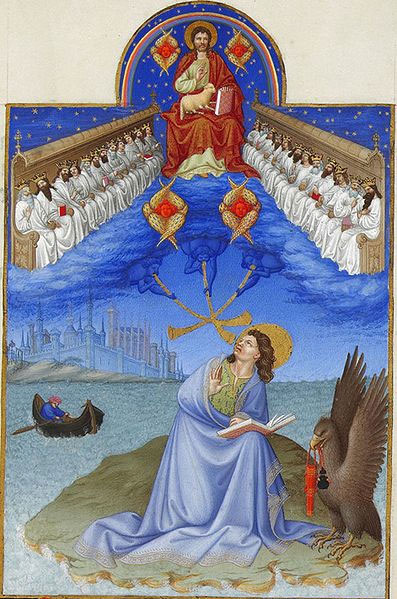
“What was from the beginning, what we have heard, what we have seen with our eyes, what we have gazed upon and our hands handled concerning the word of life—and the life was manifested, and we have seen and bear witness and announce to you the life, the eternal one, which was toward the Father and was manifested to us—what we have seen and heard, we announce also to you…”
IF I BELIEVE that the first resurrection occurred around AD70 [1], and that the New Covenant administration consists of saints living and reigning with Christ in heaven [2], these “joint-heirs” become co-mediators in some fashion. Does this open the door to the Roman Catholic practice of praying to glorified saints, or to the Eastern Orthodox love for beautiful icons?
Continue reading
8 comments | tags: AD70, Holy Place, John, Millennium, Peter Leithart, Revelation 20, Roman Catholicism | posted in Against Hyperpreterism, Biblical Theology, Quotes, The Last Days
Dec
7
2009
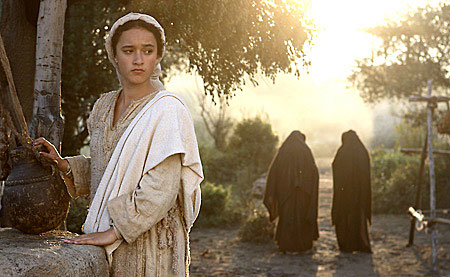
or Receiving the Implanted Word
Mary’s song, like most songs in the Bible, seemed to me to contain mostly extraneous material. My modern mind couldn’t relate her words to the version of Christianity I was familiar with. I guess that’s because it was a version bereft of much understanding of the Old Testament.
Mary’s song seems to follow the matrix pattern. As such, it is a new Creation, and a new Tabernacle, (John 1:14, “dwelt” is literally “tabernacled”). It is the liturgical response of the bride to the promise of Covenant succession – the Covenant succession. This new generation was also regeneration.
Continue reading
Comments Off | tags: Atonement, Azal, Bible Matrix, Christmas, Daniel, Dispensationalism, Feasts, Holy Place, Luke, Mary, Moses, Revelation | posted in Biblical Theology, The Last Days
Sep
27
2009
Or The Tabernacle in Genesis 3
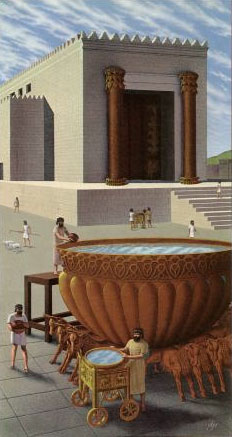 One of the best things you get from James Jordan is a big handle on the Tabernacle.[1] It was a miniature of the creation. It was also a further development of the Garden of Eden, being more glorious than the Garden itself (the trees were now worked timber, and the wood was covered in precious metal).
One of the best things you get from James Jordan is a big handle on the Tabernacle.[1] It was a miniature of the creation. It was also a further development of the Garden of Eden, being more glorious than the Garden itself (the trees were now worked timber, and the wood was covered in precious metal).
Jordan’s theory that Satan was to be a tutor to Adam and Eve, but fell in the moment he deceived them, finds support in the Tabernacle layout. (Angels tutor God’s people throughout the Old Testament.) Satan was the secondary lightbearer, the Lampstand, facing north.
Adam was to be broken bread and poured out wine, the Face of the Man, facing south, the Table of Showbread (the facebread).
Between them, Eve, the mother of all living, was the Altar of Incense. As element 5, Day 5, she is a “multitude” in one body. She is awesome as an army with banners. Women possess all their ova from birth.[2] Continue reading
Comments Off | tags: Greater Eve, Holy Place, Incense Altar, James Jordan, Lampstand, Parenting, Satan, Showbread, Tabernacle, Temple | posted in Biblical Theology, Creation
Aug
14
2009
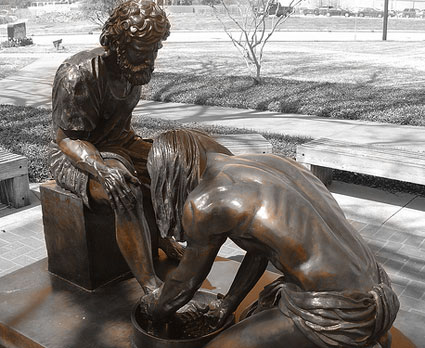
or Filling Up That Which is Lacking
After reading about the Bible’s use of robes as symbols of office (see The Dominion Trap by James B. Jordan), Tim Mitchell commented:
In Bible study we’ve been looking at John, so a few weeks ago was John 13. My Bible translated v.4-5 as “So he got up from the table, took off his robe, wrapped a towel around his waist, and poured water into a basin. Then he began to wash the disciples’ feel, drying them with the towel he had around him.”
So that recalled for me the couple of pages on robe imagery, and it seems to foreshadow what Jesus will do later on very well: He is willing to take off his authority and righteousness, and take on the dirt of our sin.
But then I got a bit unsure, since Jesus then goes on to say “you ought to wash each others’ feet” in v.14 and “Do as I have done to you” in v.15. So if the symbolism applies, how are we also supposed to take other peoples’ sin on us as Jesus did?
Firstly, what a great question. Many New Testament passages become so familiar that we often lose the ability to really think about their ramifications.
The structure of the Last Supper puts this action of Jesus at Atonement, the Laver (Day 6). Jesus is liturgically pre-enacting His role as High Priest. The Adam removed his glorious robes and wore linen for the Day of Covering. Jesus left this in the tomb with our sin on it. But that is not all the High Priest did. He approached the Most Holy twice.
Continue reading
Comments Off | tags: AD70, Against Hyperpreterism, Ahasuerus, Atonement, Daniel, Esther, Hebrews, High Priest, Holy Place, Joseph, Last Supper, Liturgy, Totus Christus | posted in Biblical Theology, Christian Life, Totus Christus
May
2
2009
Peter Leithart writes:
Reflections on a class discussion earlier today about place, our connection to the ground, and gnosticism.
- Blood and soil are “powers” that can and have dominated human life, and caused lots of human misery.
- Jesus overcomes those powers. We are identified by water and feast, not by blood or color or place.
- YET (here’s where my thought is undeveloped): Jesus doesn’t just overcome and send the powers packing. He pacifies and reconciles powers; He turns them to the purposes of His kingdom (Col 1-2).
The dilemma: How to express the reconciliation of blood and soil without falling back into the old creation, and without going fascist? How to express Jesus’ pacification of “blood” without letting it usurp the place of the water, and how to express Jesus’ pacification of “soil” without letting it usurp the place of the feast?
Continue reading
Comments Off | tags: Atonement, Canaan, Communion, Compromise, Gnosticism, Herod, High Priest, Holy Place, Most Holy Place, nationalism, Nazirite, New earth, Nimrod, Peter Leithart, Worship | posted in Biblical Theology
Apr
16
2009
A thought from a student exam: In Mark’s gospel, as soon as the veil of the temple is torn, the centurion confesses Jesus as Son of God. It’s a crucial scene because it’s the first time any human recognizes Jesus as Son.
And the sequence of veil and confession is crucial. The temple existed to keep people away from the presence of Yahweh. Jews were called to be nearer, and Gentiles further. If the temple is open, it doesn’t fulfill this function anymore. There’s a way into the holy place, and at the very moment a way is made into the holy place the division of Jew and Gentile becomes irrelevant.
Peter Leithart, www.leithart.com
Brilliant observation. It reminded me that the firmament of Day 2 (and the 2nd Tabernacle speech, which concerns the veil) correspond to the Confession in the liturgical pattern set by the Creation week.
Comments Off | tags: Creation Week, Holy Place, Peter Leithart, Tabernacle, Veil | posted in Biblical Theology
Apr
15
2009
Witness or Worship?
“…the political task of Christians is to be the church rather than to transform the world”–Stanley Hauerwas, Resident Aliens.
This presents a false dichotomy. When Gideon and David were faithful, God went ahead of them and defeated their enemies. Would it be fair to assume that Hauerwas is just saying that political activism is getting the cart before the horse? If so, then I agree with him. When the church is faithful, the blessings of God transform the world around her.
Continue reading
Comments Off | tags: Aaron, Ark of the Covenant, David, Ezekiel, Gideon, Holy Place, James Jordan, Manna, Politics, Table of Showbread | posted in Biblical Theology, Ethics
Apr
15
2009
“How is the land, is it fat or lean? Are there trees in it or not? Make an effort then to get some of the fruit of the land.” Now the time was the time of the first ripe grapes… Then they came to the valley of Eshcol and from there cut down a branch with a single cluster of grapes; and they carried it on a pole between two men. (from Numbers 13)
But Christ has indeed been raised from the dead, the firstfruits of those who have fallen asleep. (1 Corinthians 15:20)
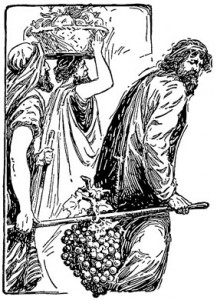 The Tabernacle is an architectural model of the world. Each of the seven speeches of the Lord (Exodus 25-31) is introduced with a variant of the phrase “Then Yahweh spoke to Moses, saying.” The seven speeches follow the pattern of the seven days of the Creation week, and also the seven feasts in Leviticus 23.
The Tabernacle is an architectural model of the world. Each of the seven speeches of the Lord (Exodus 25-31) is introduced with a variant of the phrase “Then Yahweh spoke to Moses, saying.” The seven speeches follow the pattern of the seven days of the Creation week, and also the seven feasts in Leviticus 23.
The Table of Showbread corresponds to both the grain and fruit created on Day 3, the Feast of Firstfruits and to the Asension of Moses.
This pattern began in the garden, when after Adam’s “Red Sea” death and resurrection, he was united to his bride by Covenant. He “ascended” as covenant head of a new family, with God’s one Law.
On the table in the Holy Place were twelve loaves of bread and jugs of beer (from grain), and later, wine. Like the manna and the grapes of Eshcol, these were a promise of rest and rule with God on a future Sabbath as priest and king. Here is the last supper. As with Adam and Moses, this initial promise of wine was followed by exposure to the serpent for testing under the Law – Pentecost.
Just as the marriage covenant of Adam and Eve at Firstfruits is really a betrothal of their united marriage to God on Day 7, so this Table of Israel was a promise of future glory to the whole world at the final Sabbath feast, Tabernacles.
To use Doug Wilson’s phrase, human marriage is “manifest glory.” It is a Day 3 picture of the Day 7 rest to come at the union of heaven and earth.
Comments Off | tags: Adam, Betrothal, Booths, Doug Wilson, Firstfruits, Holy Place, Last Supper, Manna, Marriage, Numbers, Pentecost, Tabernacle, Tabernacles, Wine | posted in Biblical Theology






























